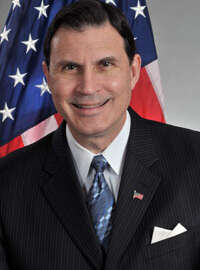One of longest serving CIOs adds to his résumé with new council role
An unusually active last few weeks in the federal IT community brings changes in executive positions at DHS, EPA, GSA and USDA.
Maybe it has something to do with the time of year, but the number of federal executives on the move is a bit unsettling.
Let’s start with some good news. Joe Klimavicz, the Justice Department chief information officer, received some much-deserved recognition for his leadership in bringing change to the agencies he works for by being elected as the new vice chairman of the CIO Council.
Klimavicz replaces Luke McCormack, the former Homeland Security Department CIO who retired in January 2017.
Klimavicz has been the Justice CIO since April 2014 and has been making progress in integrating DoJ’s technology, consolidating email systems from 23 to 9 and promoting shared services.
The vice chairman, which has included Dave Wennergren and Richard Spires along with McCormack, traditionally has helped bridge the political and career technology managers.
It’s a smart move by federal CIO Suzette Kent to have both Klimavicz, who is one of the longest tenured CIOs, and Margie Graves, the deputy federal CIO, to help her navigate the often confusing and tricky world of federal IT.
The Environmental Protection Agency and DHS also are starting to fill some IT executive holes in their lineups.
EPA named Rob McKinney to be the new chief information security officer.
Sources confirmed McKinney ascends from his acting position to the permanent CISO role. McKinney has been with EPA since 2010 and previously worked at the National Weather Service and Veterans Affairs Department in cyber executive positions.
Over at DHS, John Zangardi, the new CIO, is trying to stay ahead of the talent wave that is crashing around him.
Since January, DHS has lost its chief technology officer, a senior technology adviser and its chief information security officer, while its deputy CTO left in October.
Zangardi named Paul Beckman as DHS’ new CISO in April, and now is bringing in Joe Harris from FEMA to be the new executive director of the IT services organization to replace Jim Flanagan, who is retiring.
He’s also changing the CTO’s role to be the chief technical officer.
“One of my roles in DHS is I’m the IT technical authority and I want to make sure we are focused on the technical,” Zangardi said at the DHS industry day sponsored by Washington Technology on Friday in McLean, Virginia. “We’ve picked an individual and we are going through that SES hiring process with OPM.”
Zangardi will continue to be busy filling holes in his staff.
Darryl Peek, the DHS director of digital innovation and solutions, is leaving to join Salesforce after five years in government.
Peek joined DHS’ federal network resilience group in 2013 and moved to the CIO’s staff in June 2016.
Additionally, Barry West, who has been a senior adviser and deputy CIO for DHS, announced he is retiring on May 31.
And finally, Josh Ziman, who was in charge of the DHS initiative called Cloud Factory, left in April to join Cisco as a service delivery manager, according to his LinkedIn page. Cloud factory is DHS’ shared services capabilities to provide a fully automated provisioning and delivery lifecycle of cloud services.
Two other departures also are worth mentioning.
Jon Johnson, the General Services Administration’s director of enterprise mobility for the last five years, is moving to industry.
Latest Technology News
Sources confirmed his last day is June 1. It’s unclear where he will go. Industry sources say he will remain in the federal market.
“I will not be going far and will remain here in DC working from the private sector to continue to advance technology in a smart, meaningful, impactful, mission-driven way that drives efficiency and effectiveness of mission and operations across government,” Johnson wrote in an email sent to industry associates and obtained by Federal News Radio. “That desire, and that role, will not change. The only thing that changes is where I will be doing this from.”
Johnson joined GSA in 2009 as a contracting officer and began working on mobility initiatives in 2012.
He led the governmentwide Mobile Services Category Team, which has helped agencies save more than $500 million on mobile devices and services through better management and buying.
Today, agencies are paying on average almost $20 a month less for mobile services and devices with some paying as much as $30 less because of the team’s work.
Jonathan Benett, the Agriculture Department’s chief enterprise architect, left government after a decade and will join Adobe Systems’ public sector team in June.
“It was a very difficult decision because of my love of the USDA mission and public service. But sometimes when an incredible opportunity comes your way … you have to take a leap of faith!” Bennett said in an email to colleagues, which Federal News Radio obtained.
He joined the government in 2008 to lead the project management office at the Patent and Trademark Office in the Commerce Department and then moved to USDA where he worked in a variety of roles.
Benett also is well known for his volunteer activity in the federal community, holding executive board positions for ACT/IAC, AFCEA Bethesda and AFFIRM, and most recently he was the government chairman of the Young AFCEA Bethesda Government Advisory Council and co-founder/chairman of the Federal Project Management Community of Practice.
Read more of Reporter’s Notebook
Copyright © 2025 Federal News Network. All rights reserved. This website is not intended for users located within the European Economic Area.
Jason Miller is executive editor of Federal News Network and directs news coverage on the people, policy and programs of the federal government.
Follow @jmillerWFED






